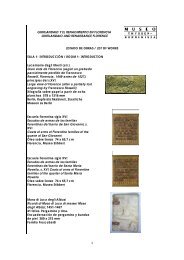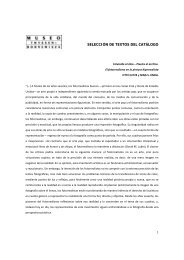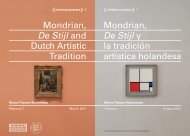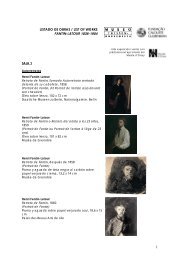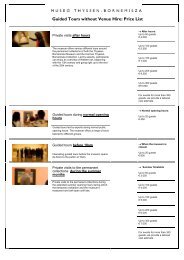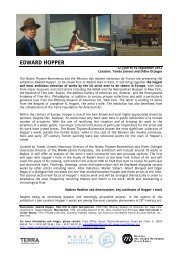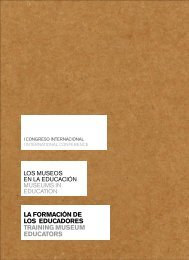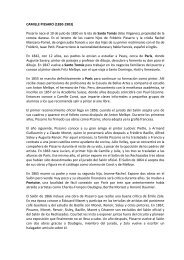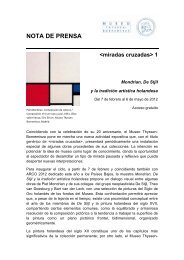Folleto de la exposición - Museo Thyssen-Bornemisza
Folleto de la exposición - Museo Thyssen-Bornemisza
Folleto de la exposición - Museo Thyssen-Bornemisza
- No tags were found...
You also want an ePaper? Increase the reach of your titles
YUMPU automatically turns print PDFs into web optimized ePapers that Google loves.
FechasDel 12 <strong>de</strong> junio al 16 <strong>de</strong> septiembre <strong>de</strong> 2012.LugarSa<strong>la</strong> <strong>de</strong> exposiciones temporales. P<strong>la</strong>nta baja.HorarioDe martes a sábado, <strong>de</strong> 10.00 a 23.00 h.Lunes y domingo, <strong>de</strong> 10.00 a 19.00 h. Lunes20 <strong>de</strong> agosto cerrado. Como complementoa <strong>la</strong> visita se pue<strong>de</strong> cenar en el restauranteterrazaEl Mirador, situado en <strong>la</strong> p<strong>la</strong>nta ático <strong>de</strong>l<strong>Museo</strong>. El <strong>de</strong>salojo <strong>de</strong> <strong>la</strong>s sa<strong>la</strong>s <strong>de</strong> exposicióntendrá lugar cinco minutos antes <strong>de</strong>l cierre.Venta <strong>de</strong> entradas• Aforo limitado. Para asegurarse el accesoa <strong>la</strong> exposición en el día y hora <strong>de</strong>seados,recomendamos adquirir <strong>la</strong>s entradasanticipadamente. Sistema <strong>de</strong> venta<strong>de</strong> entradas con hora asignada y accesogarantizado a <strong>la</strong> exposición en el díay hora elegido.• Venta anticipada:Taquil<strong>la</strong> <strong>de</strong>l <strong>Museo</strong>www.museothyssen.orgTel.: 902 760 511Tarifas• General:Colecciones <strong>Thyssen</strong>-<strong>Bornemisza</strong>: 9,00 €Exposición Hopper: 10,00 €Entrada combinada para <strong>la</strong>s Colecciones<strong>Thyssen</strong>-<strong>Bornemisza</strong> y <strong>la</strong> exposiciónHopper: 15,00 €• Mayores <strong>de</strong> 65 años, pensionistas,estudiantes, titu<strong>la</strong>res <strong>de</strong> Carné Joven,profesores <strong>de</strong> Bel<strong>la</strong>s Artes, ciudadanos condiscapacidad superior al 33% y miembros<strong>de</strong> familia numerosa, previa acreditación:Colecciones <strong>Thyssen</strong>-<strong>Bornemisza</strong>: 6,00 €Exposición Hopper: 6,00 €Entrada combinada para <strong>la</strong>s Colecciones<strong>Thyssen</strong>-<strong>Bornemisza</strong> y <strong>la</strong> exposiciónHopper: 8,00 €• Gratuita: menores <strong>de</strong> 12 años acompañadosy ciudadanos en situación legal <strong>de</strong><strong>de</strong>sempleo, previa acreditación.Dates12 June to 16 September 2012.VenueTemporary exhibition galleries. Ground Floor.Opening timesTuesdays to Saturdays, 10am to 11pm.Mondays and Sundays, 10am to 7pm.Closed on Monday 20 August. El MiradorRestaurant offers the i<strong>de</strong>al accompanimentto a visit, located on Museum’s top floor.Visitors are asked to leave the galleries fiveminutes before closing.Ticket sales• Limited entry numbers. Early bookingis recommen<strong>de</strong>d to ensure entry forthe chosen day and time. Ticket salesoffering guaranteed entry for the selectedday and time.• Pre-booked tickets:At the Museum’s ticket <strong>de</strong>skswww.museothyssen.orgTel: 902 760 511Ticket prices• General:<strong>Thyssen</strong>-<strong>Bornemisza</strong> Collections: 9,00 €Hopper exhibition: 10,00 €Combined ticket for <strong>Thyssen</strong>-<strong>Bornemisza</strong>Collections and Hopper exhibition: 15,00 €• Senior citizens (65 and over), pensioners,Carné Joven hol<strong>de</strong>rs, Fine Arts teachers,stu<strong>de</strong>nts, Disabled with 33% ratingand members of <strong>la</strong>rge families, with proofof status:<strong>Thyssen</strong>-<strong>Bornemisza</strong> Collections: 6,00 €Hopper exhibition: 6,00 €Combined ticket for <strong>Thyssen</strong>-<strong>Bornemisza</strong>Collections and Hopper exhibition: 8,00 €• Free admission: Accompanied childrenun<strong>de</strong>r 12 and officialy unemployed people.
EDWARD HOPPER1882-1967Edward Hopper nació en Nyack y vivió durante toda su vida en Nueva York,aunque pasó veraneos <strong>la</strong>rgos junto al mar en su estudio <strong>de</strong> Cape Cod. Hijo<strong>de</strong> un matrimonio <strong>de</strong> c<strong>la</strong>se media mo<strong>de</strong>sta, manifestó su vocación por <strong>la</strong>pintura <strong>de</strong>s<strong>de</strong> muy joven. Tras estudiar ilustración comercial durante unaño, se matriculó en los cursos <strong>de</strong> pintura <strong>de</strong> <strong>la</strong> New York School of Art,cuyo director era William Merritt Chase. Allí se inscribió en el taller <strong>de</strong>Robert Henri, un profesor que <strong>de</strong>fendía un realismo orientado hacia <strong>la</strong>representación <strong>de</strong> temas <strong>de</strong> <strong>la</strong> vida cotidiana <strong>de</strong> <strong>la</strong> sociedad americana.Terminados sus estudios, Hopper viajó a París y permaneció allí duranteel curso <strong>de</strong> 1906-1907. Volvió a <strong>la</strong> capital francesa, en estancias más cortasen 1909 y 1910. A partir <strong>de</strong> entonces y hasta su fallecimiento en 1967sólo salió <strong>de</strong>l territorio <strong>de</strong> los Estados Unidos para hacer un par <strong>de</strong> viajes<strong>de</strong> corta duración a México.Edward Hopper was born in Nyack and lived all his life in New York althoughhe spent long summers by the sea in his Cape Cod studio. Borninto a mo<strong>de</strong>st, middle-c<strong>la</strong>ss family, Hopper’s interest in painting revealeditself at a very young age. He studied commercial illustration for a yearthen enrolled in the painting c<strong>la</strong>sses at the New York School of Art, directedby William Merritt Chase. There Hopper joined the studio of RobertHenri, a teacher who promoted a realism that focused on the <strong>de</strong>pictionof everyday American life. Having completed his studies Hopper went toParis where he spent the aca<strong>de</strong>mic year 1906–07, returning there for shorterperiods in 1909 and 1910. From that date onwards until his <strong>de</strong>ath in1967 the artist only left the United States to make a couple of short tripsto Mexico.
Autorretrato, 1925-1930Óleo sobre lienzo. 64,1 x 52,3 cmWhitney Museum of American Art, Nueva York.Legado Josephine N. Hopper; inv.: 70.1165Self-Portrait, 1925–30Oil on canvas. 64.1 x 52.3 cm.Whitney Museum of American Art, New York,Josephine N. Hopper bequest; inv. no. 70.1165Durante muchos años Hopper vivió trabajando como ilustrador comercial.A partir <strong>de</strong> 1918 empezó a adquirir reputación como grabador,pero el verda<strong>de</strong>ro cambio <strong>de</strong> fortuna se produjo en 1925, cuando una exposiciónsuya <strong>de</strong> acuare<strong>la</strong>s en <strong>la</strong> Rehn Gallery se vendió por completo.Este éxito le permitió <strong>de</strong>dicarse a <strong>la</strong> pintura <strong>de</strong> manera exclusiva. En 1933el MoMA hizo una gran muestra monográfica <strong>de</strong> su obra. La siguientemonográfica <strong>la</strong> organizó en 1950 el Whitney Museum of American Art,institución que se ocupó <strong>de</strong>s<strong>de</strong> entonces <strong>de</strong> estudiar y divulgar su obray que conserva hoy <strong>la</strong> colección más importante <strong>de</strong> Hopper.FORMACIÓN E INFLUENCIASLa influencia más significativa en <strong>la</strong> formación <strong>de</strong> Hopper fue el realismoque <strong>de</strong>fendía su profesor Robert Henri. Se <strong>de</strong>finía por su oposicióntanto al aca<strong>de</strong>micismo, todavía muy presente a comienzos <strong>de</strong>l siglo XX,como al l<strong>la</strong>mado impresionismo americano, una ten<strong>de</strong>ncia que los realistasconsi<strong>de</strong>raban artificiosa y ajena a <strong>la</strong> cultura americana. La primeramanifestación pública <strong>de</strong>l grupo <strong>de</strong> pintores realistas fue una exposición
Habitación <strong>de</strong> hotel, 1931Óleo sobre lienzo.152,4 x 165,7 cm<strong>Museo</strong> <strong>Thyssen</strong>-<strong>Bornemisza</strong>,Madrid; inv.: 1977.110Hotel Room, 1931Oil on canvas.152.4 x 165.7 cm<strong>Museo</strong> <strong>Thyssen</strong>-<strong>Bornemisza</strong>;Madrid; inv. no. 1977.110Hopper worked for many years as a commercial illustrator but from1918 began to acquire a reputation as a printmaker. His real change of fortunes,however, came about in 1925 when an exhibition of his watercoloursat the Rehn Gallery was completely sold out. This success allowedhim to <strong>de</strong>dicate himself entirely to painting. In 1933 the MoMA ma<strong>de</strong>Hopper the subject of a major solo exhibition, which was followed byanother one in 1950 at the Whitney Museum of American Art. From thatdate onwards, the Whitney embarked on the study and dissemination ofthe artist’s work, of which it now houses the most important collection.TRAINING AND INFLUENCESThe most important influence on Hopper’s training was the realism championedby his teacher Robert Henri. This realism constituted both anopposition to aca<strong>de</strong>micism, which was still notably present in the early20 th century, and to so-called American Impressionism, which was a typeof mo<strong>de</strong>rn art that the realists consi<strong>de</strong>red artificial and alien to Americanculture. The first public manifestation of the new trend was a group show
Soir bleu, 1914. Óleo sobre lienzo. 91,4 x 182,9 cm. Whitney Museum of American Art, Nueva York.Legado Josephine N. Hopper; inv.: 70.1208Soir Bleu, 1914. Oil on canvas. 91.4 x 182.9 cm. Whitney Museum of American Art, New York,Josephine N. Hopper bequest; inv. no. 70.1208colectiva organizada por Robert Henri en 1908 en <strong>la</strong>s Macbeth Galleries<strong>de</strong> Nueva York y sus representantes más <strong>de</strong>stacados, aparte <strong>de</strong>l mismoHenri, eran John Sloan y George Bellows. Aunque Hopper quedó al margen<strong>de</strong>l grupo, estaba próximo a él y compartía en buena medida su i<strong>de</strong>arioartístico y sus referencias históricas, especialmente <strong>la</strong> admiración porVelázquez, el realismo ho<strong>la</strong>ndés <strong>de</strong>l siglo XVII, Courbet y Manet. Sus estanciasen París (con breves viajes a Ho<strong>la</strong>nda y a España) le confirmaronen el realismo, pero le permitieron también estudiar <strong>la</strong> pintura impresionista,que influyó <strong>de</strong>cisivamente en su manera <strong>de</strong> enten<strong>de</strong>r el color.Otros pintores europeos que suscitaron su interés y le ayudaron a configurarsu lenguaje pictórico fueron Albert Marquet, Félix Vallotton y elbritánico Walter Sickert. Sickert era un seguidor <strong>de</strong> Degas y <strong>la</strong> <strong>de</strong> esteúltimo artista fue seguramente <strong>la</strong> influencia más profunda y dura<strong>de</strong>ra querecibió Hopper. No sólo adoptó, reinterpretándolos, muchos recursos pictóricos<strong>de</strong>l maestro francés, sino que hizo suya su aproximación elusivae intimista <strong>de</strong> <strong>la</strong> vida mo<strong>de</strong>rna, así como su concepción <strong>de</strong> <strong>la</strong> posición singu<strong>la</strong>ry a <strong>la</strong> vez marginal que el artista ocupa en el<strong>la</strong>.
Dos cómicos, 1966. Óleo sobre lienzo. 78,1 x 106 cmColección privadaTwo Comedians, 1966. Oil on canvas. 78.1 x 106 cmPrivate collectionorganised by Robert Henri in 1908 at the Macbeth Galleries in New York.Apart from Henri himself the most important representatives of the newstyle to be seen in the exhibition were John Sloan and George Bellows.Although Hopper remained apart from the group he was close to it andshared its artistic i<strong>de</strong>as and historical references to a consi<strong>de</strong>rable <strong>de</strong>gree,particu<strong>la</strong>rly an admiration for Velázquez, 17 th -century Dutch realism,Courbet and Manet. Hopper’s trips to Paris (from where he ma<strong>de</strong> shortvisits to Hol<strong>la</strong>nd and Spain) confirmed his commitment to realism but alsoallowed him to study Impressionist painting, which had a <strong>de</strong>cisive influenceon his way of un<strong>de</strong>rstanding colour. Other painters who interested him andhelped him to formu<strong>la</strong>te his own pictorial <strong>la</strong>nguage were Albert Marquet,Félix Vallotton and the British painter Walter Sickert. Sickert was a followerof Degas, who would ultimately prove Hopper’s most importantand long-<strong>la</strong>sting influence. Not only did he adopt and reinterpret manyof Degas’ pictorial <strong>de</strong>vices but also assimi<strong>la</strong>ted his elusive and intimateconcept of mo<strong>de</strong>rn life as well as Degas’ awareness of the artist’s privilegedbut marginal position in society.
Casas en Squam Light, Gloucester, 1923. Acuare<strong>la</strong> sobre papel. 28,6 x 44,3 cmMuseum of Fine Arts, Boston, legado <strong>de</strong> John T. Spaulding; inv.: 48.716Houses of Squam Light, Gloucester, 1923. Watercolour on paper. 28.6 x 44.3 cmMuseum of Fine Arts, Boston, bequest of John T. Spaulding; inv. no. 48.716Pintada en Nueva York en 1914, Soir bleu es <strong>la</strong> obra maestra que resumey concluye los años <strong>de</strong> aprendizaje <strong>de</strong> Hopper. Titu<strong>la</strong>do por el propio artistaen francés citando un verso <strong>de</strong> Rimbaud, el cuadro representa unaescena crepuscu<strong>la</strong>r en <strong>la</strong> terraza <strong>de</strong> un café <strong>de</strong> París que <strong>de</strong>be leerse comouna alegoría <strong>de</strong> <strong>la</strong> vida mo<strong>de</strong>rna. La figura <strong>de</strong> Pierrot, un autorretrato <strong>de</strong>lpintor que ocupa una posición central en <strong>la</strong> composición, volverá a aparecersólo una vez más en su obra. Será en Dos cómicos (1966) el últimocuadro pintado por Hopper.GRABADOS Y ACUARELASDurante muchos años <strong>la</strong> pintura <strong>de</strong> Hopper fue poco apreciada por elpúblico y por <strong>la</strong> crítica y el artista tuvo que vivir trabajando como ilustradorcomercial, una actividad para <strong>la</strong> que estaba bien dotado, pero que<strong>de</strong>testaba. En 1915 comenzó a experimentar con el grabado calcográfico.Un prece<strong>de</strong>nte relevante para Hopper en el uso <strong>de</strong> esta técnica era Manet,aunque <strong>la</strong> referencia fundamental fue Rembrandt. Fue el maestro ho<strong>la</strong>ndésquien le ayudó a enten<strong>de</strong>r <strong>la</strong> importancia <strong>de</strong> <strong>la</strong> luz y <strong>la</strong> manera <strong>de</strong>llevar<strong>la</strong> al papel para <strong>de</strong>finir el ambiente y el carácter <strong>de</strong> <strong>la</strong>s escenas representadas.Entre 1918 y 1923, año en que abandonó esa técnica, Hopper realizóuna treintena <strong>de</strong> grabados. En ellos se apuntan ya <strong>la</strong>s gran<strong>de</strong>s líneas
Casa junto a <strong>la</strong> vía<strong>de</strong>l tren,1925Óleo sobre lienzo. 61 x 73,7 cmThe Museum of Mo<strong>de</strong>rn Art,Nueva York. Donadoanónimamente, 1930;inv.: 3.1930House by the Railroad, 1925Oil on canvas. 61 x 73.7 cmThe Museum of Mo<strong>de</strong>rn Art,New York, anonymous giftof 1930; inv. no. 3.1930Painted in New York in 1914, Soir Bleu is the masterpiece that summarisesand conclu<strong>de</strong>s Hopper’s years of study and learning. Titled in Frenchby the artist with a reference to a line of verse by Rimbaud, the painting<strong>de</strong>picts an evening scene on a café terrace in Paris and should be interpretedas an allegory of mo<strong>de</strong>rn life. The figure of Pierrot, a self-portraitof Hopper that occupies a central position in the composition, wouldonly reappear once more in his work, in his final painting, Two Comedians(1966).PRINTS AND WATERCOLOURSFor many years Hopper’s painting failed to find favour with the public orcritics and he was thus obliged to work as a commercial illustrator, an activityin which he was gifted but which he loathed. In 1915 he began toexperiment with copper-p<strong>la</strong>te etching. An important prece<strong>de</strong>nt in the useof this technique was provi<strong>de</strong>d by Manet, although Hopper’s key point ofreference was Rembrandt, whose prints helped him to un<strong>de</strong>rstand theimportance of light and to make use of it in prints in or<strong>de</strong>r to create the atmosphereand character of the scene <strong>de</strong>picted. Between 1918 and 1923,the year he abandoned this technique, Hopper ma<strong>de</strong> around 30 prints inwhich he established the principal themes and subjects that he would
temáticas que iba a <strong>de</strong>sarrol<strong>la</strong>r posteriormente en su pintura. Los grabados<strong>de</strong> Hopper fueron muy bien recibidos en el mundo artístico <strong>de</strong> NuevaYork y en 1923 el <strong>Museo</strong> <strong>de</strong> Brooklyn adquirió uno <strong>de</strong> ellos. Era <strong>la</strong> primeraobra <strong>de</strong>l artista que entraba en un museo.Des<strong>de</strong> sus años <strong>de</strong> formación en <strong>la</strong> New York School of Art Hoppertuvo ocasión <strong>de</strong> familiarizarse con <strong>la</strong> práctica <strong>de</strong> <strong>la</strong> acuare<strong>la</strong>, una técnicaque contaba con antece<strong>de</strong>ntes importantes en <strong>la</strong> tradición artística norteamericana.Hacia finales <strong>de</strong> <strong>la</strong> segunda década <strong>de</strong>l siglo XX comenzó atrabajar en una serie <strong>de</strong> acuare<strong>la</strong>s <strong>de</strong> tema paisajístico. Seguía con ello uncamino que en <strong>la</strong> generación anterior había abierto el pintor norteamericanoWinslow Homer. A diferencia <strong>de</strong> Homer, Hopper no se interesabapor <strong>la</strong> naturaleza, ni por el paisaje rural, sino que se centraba en vistasurbanas o suburbanas. En 1925 el marchante Frank Rehn mostró ensu galería un conjunto <strong>de</strong> acuare<strong>la</strong>s <strong>de</strong> Hopper. Fue <strong>la</strong> primera exposiciónindividual <strong>de</strong>l artista y se vendieron todas <strong>la</strong>s obras expuestas. El éxitopermitió que Hopper abandonara su trabajo <strong>de</strong> ilustrador para <strong>de</strong>dicarseexclusivamente a <strong>la</strong> pintura. Tenía entonces 43 años.subsequently <strong>de</strong>velop in his paintings. These etchings were extremelywell received by the American art world and by museums and in 1923 theBrooklyn Museum acquired one of them, which was thus the first workby Hopper to enter a museum.During his years of training at the New York School of Art, Hopper learnedthe technique of watercolour, which had important prece<strong>de</strong>nts in theAmerican tradition. Around the end of the second <strong>de</strong>ca<strong>de</strong> of the 20 th centuryhe began to work on a series of watercolours on <strong>la</strong>ndscape subjects,following a direction marked out by the American artist Winslow Homer.In contrast to Homer, Hopper’s focus was not that of nature nor the rural<strong>la</strong>ndscape but rather urban or suburban views. In 1925 the art <strong>de</strong>aler FrankRehn showed a group of Hopper’s watercolours at his gallery in what wasthe artist’s first solo exhibition. All the works exhibited were sold, a successthat allowed Hopper to give up his work as an illustrator and <strong>de</strong>votehimself entirely to painting. By this date he was forty-three.
El Loop <strong>de</strong>l puente <strong>de</strong> Manhattan, 1928. Óleo sobre lienzo. 88,9 x 152,4 cmAddison Gallery of American Art, Phillips Aca<strong>de</strong>my, Andover. Donación <strong>de</strong> StephenC. C<strong>la</strong>rk, Esq.; inv.: 1932.17Manhattan Bridge Loop, 1928. Oil on canvas. 88.9 x 152.4 cm. Addison Gallery ofAmerican Art, Phillips Aca<strong>de</strong>my, Andover, gift of Stephen C. C<strong>la</strong>rk, Esq; inv. no. 1932.17Gasolina, 1940. Óleo sobre lienzo. 66,7 x 102,2 cm. The Museum of Mo<strong>de</strong>rn Art,Nueva York. Mrs. Simon Guggenheim Fund, 1943; inv.: 577.1943Gas, 1940. Oil on canvas. 66.7 x 102.2 cm. The Museum of Mo<strong>de</strong>rn Art, New York,Mrs Simon Guggenheim Fund; inv. no. 577.1943
Dos puritanos, 1945. Óleo sobre lienzo. 76,2 x 101,6 cmColección privada; Cortesía <strong>de</strong> Ronald Feldman Fine Arts, Nueva YorkTwo Puritans, 1945. Oil on canvas. 76.2 x 101.6 cmPrivate collection, courtesy Ronald Feldman Fine Arts, New YorkEL PAISAJE NORTEAMERICANOEl paisajismo había sido el género más importante <strong>de</strong> <strong>la</strong> pintura norteamericana<strong>de</strong>l siglo XIX. Aunque cultivó también otros tipos <strong>de</strong> pintura, elrápido crecimiento <strong>de</strong> <strong>la</strong> reputación <strong>de</strong> Hopper durante <strong>la</strong> segunda mitad<strong>de</strong> los años veinte se <strong>de</strong>bió sobre todo a sus paisajes. Su obra, sin embargo,supone una ruptura respecto <strong>de</strong> <strong>la</strong> tradición <strong>de</strong>cimonónica, ya quese centra sobre todo en <strong>la</strong>s vistas urbanas <strong>de</strong> Manhattan o en <strong>la</strong>s zonas resi<strong>de</strong>nciales<strong>de</strong> <strong>la</strong>s periferias urbanas. Lo hace sin con<strong>de</strong>scen<strong>de</strong>ncia alguna,subrayando <strong>la</strong> vulgaridad y <strong>la</strong> inhospitalidad <strong>de</strong> los lugares pintados.Un ejemplo característico lo encontramos en su representación <strong>de</strong> lospuentes suspendidos que unen Manhattan con Brooklyn, gran<strong>de</strong>s obras<strong>de</strong> ingeniería que suscitaban <strong>la</strong> admiración popu<strong>la</strong>r pero que él representacomo espacios ásperos y <strong>de</strong>so<strong>la</strong>dos en los que lo único que parece interesarlees su complejidad visual.Aunque Hopper pintó también paisajes abiertos, frecuentemente situadosen <strong>la</strong>s cercanías <strong>de</strong> Cape Cod, lugar don<strong>de</strong> había construido una casaestudioen <strong>la</strong> que solía veranear, sus temas preferidos siguieron siendo <strong>la</strong>s
Неудачи — это хорошо!Но два года спустя, в 1860 году, Авраам Линкольн стал президентомСоединенных Штатов.Вера в себя, в свой успех иногда остается единственным оружиемв борьбе с превратностями жизни. Но именно она способна статьтем рычагом, который может помочь человеку перевернуть мир —обернуть неудачи в блестящую победу.Фрэнк Вулворт мечтал стать продавцом. Для получения опытаон два года бесплатно работал клерком в бакалейном магазине. Потомперешел работать в большой магазин, где получал 3,5 доллара внеделю. Этих денег ему едва хватало, чтобы оплатить комнату истол. Затем он стал зарабатывать уже 10 долларов. Это его настольковдохновило, что он решил жениться. Но хозяин внезапно снизилему зарплату до 8,5 доллара, мотивируя это тем, что продавец он неважныйи есть немало работников, которые работают лучше. Фрэнкнастолько потерял веру в себя, что вынужден был целый год лечитьсяот нервного расстройства. Мать говорила ему: «Придет время, сынок,и ты станешь богачом!», но никаких оснований для оптимизма,казалось бы, не было.Неожиданно бывший хозяин вызвал его и поручил оформлениевитрин и обустройство новых магазинов — это у Фрэнка получалосьлучше всего. Тогда он и узнал, что есть магазины, где торгуют пятицентовымтоваром, и торговля идет очень бойко. Ему поручили открытьтакой магазин. Но магазин обанкротился.Фрэнк понял, что пятицентовый барьер сужает возможностипродавца, и начал торговать и десятицентовыми товарами. Три изпяти таких магазинов у него прогорели.Но Фрэнк не сдавался, он сумел убедить брата и несколькихакционеров вложить деньги и развернуть целую сеть подобныхмагазинов.Спустя пятнадцать лет магазины дешевых товаров «Ф. У. Вулворт»покрывали всю Америку и принесли ему первый миллион долларов.К концу жизни он стал владельцем более тысячи магазинов,продающих товаров на 100 миллионов долларов ежегодно. Только наличном счету Вулворта было 65 миллионов долларов.13
Carretera <strong>de</strong> cuatro carriles, 1956Óleo sobre lienzo. 69,9 x 105,4 cm. Colección privadaFour Lane Road, 1956Oil on canvas. 69.9 x 105.4 cm. Private collectionobras <strong>de</strong>bidas a <strong>la</strong> mano <strong>de</strong>l hombre. Con el transcurrir <strong>de</strong> los años <strong>de</strong>dicóuna atención cada vez mayor a <strong>la</strong>s casas ais<strong>la</strong>das, presentándo<strong>la</strong>s frecuentementecomo indicios o síntomas <strong>de</strong> una cierta manera <strong>de</strong> vivir y situarseante <strong>la</strong> vida. En Dos puritanos encontramos un buen ejemplo <strong>de</strong> esa transformación<strong>de</strong> lo arquitectónico en psicológico.A<strong>de</strong>más <strong>de</strong> casas los cuadros <strong>de</strong> Hopper representan carreteras, gasolineras,vías o estaciones <strong>de</strong> tren, construcciones que se asocian a <strong>la</strong> movilidadgeográfica y al <strong>de</strong>sarraigo, unos rasgos sociales que se fueron acentuandocon <strong>la</strong> <strong>de</strong>presión económica <strong>de</strong> los años treinta y quedaron inscritosprofundamente en el imaginario colectivo norteamericano.Durante los últimos quince años <strong>de</strong> su vida, al tiempo que <strong>la</strong> producción<strong>de</strong> Hopper se hace todavía más lenta, sus composiciones se hacenmás simples, su materia pictórica más seca y ligera y sus escenas másexpresivas, llegando en algunos casos a evocar <strong>la</strong> pintura <strong>de</strong> los primitivositalianos, como Giotto. Un buen ejemplo <strong>de</strong> todo ello pue<strong>de</strong> verse enMañana en Carolina <strong>de</strong>l Sur.
Habitación en Nueva York, 1932. Óleo sobre lienzo. 74,4 x 93 cm. Sheldon Museum of Art,University of Nebraska-Lincoln, F. M. Hall Collection; inv.: H-166Room in New York, 1932. Oil on canvas. 74.4 x 93 cm. Lincoln, Sheldon Museum of Art,University of Nebraska-Lincoln UNL-F.M. Hall Collection; inv. no. H-166presenting them as signs or manifestations of a particu<strong>la</strong>r lifestyle andattitu<strong>de</strong>. Two Puritans offers a good example of this transformation ofthe architectural into the psychological.In addition to the houses in his paintings, Hopper also <strong>de</strong>pictedroads, gas stations and railway lines and stations, all constructions associatedwith geographical mobility and rootlessness, social traits thatwere increasingly evi<strong>de</strong>nt with the economic <strong>de</strong>pression of the 1930sand which became profoundly inscribed in the collective Americanimagination.During the <strong>la</strong>st fifteen years of his life the artist worked even moreslowly while his compositions became increasingly simple, his applicationof the paint dryer and lighter and his scenes more expressive, insome cases to the point of evoking the work of the Early Italian Primitivessuch as Giotto. A good example of all these characteristics is SouthCarolina Morning.
ESCENAS DE INTERIORLas escenas <strong>de</strong> <strong>la</strong> vida cotidiana situadas en interiores domésticos constituyenun género muy conocido en <strong>la</strong> historia <strong>de</strong>l arte cuyo paradigma originalse encuentra en <strong>la</strong> pintura ho<strong>la</strong>n<strong>de</strong>sa <strong>de</strong>l siglo XVII. Por su propia naturalezase asocian espontáneamente con <strong>la</strong> expresión verbal, bien porque<strong>de</strong>scriben ciertos personajes o situaciones sociales que se nos presentancomo típicos, bien porque sugieren alguna historia que nos parece <strong>de</strong> algúnmodo familiar, bien por una combinación <strong>de</strong> ambas características.En el siglo XIX el género adquirió una gran popu<strong>la</strong>ridad y fue cultivado,entre otros, por Manet y los pintores <strong>de</strong>l grupo impresionista. Los escenariosse ampliaron para incluir lugares públicos, tales como los interiores<strong>de</strong> teatros, cafés, hoteles, etc. El motor <strong>de</strong> esa transformación erael <strong>de</strong>seo <strong>de</strong> los artistas mo<strong>de</strong>rnos <strong>de</strong> reflejar <strong>la</strong>s nuevas costumbres y losnuevos estados <strong>de</strong> ánimo inducidos por los cambios sociales <strong>de</strong> <strong>la</strong> época,especialmente los que <strong>de</strong>rivaban <strong>de</strong>l crecimiento rápido y <strong>de</strong>sor<strong>de</strong>nado<strong>de</strong> <strong>la</strong>s nuevas metrópolis industriales y financieras, como París, LondresINTERIOR SCENESScenes of daily life located in domestic interiors are a celebrated genrewithin the history of art, dating back to 17 th -century Dutch painting. Dueto their inherent nature they are linked to verbal expression, either becausethey <strong>de</strong>scribe typical characters or social situations or because theysuggest a story that seems in some way familiar to us, or a combinationof both.In the 19 th century this genre became extremely popu<strong>la</strong>r and was used byartists such as Manet and the Impressionist painters. The settings of theseworks were expan<strong>de</strong>d to encompass public venues including theatres,cafés and hotels, a change that reflected mo<strong>de</strong>rn artists’ <strong>de</strong>sires to reflectthe new habits and mindsets arising from the social transformations of theperiod, particu<strong>la</strong>rly those re<strong>la</strong>ting to the rapid and chaotic growth of the newindustrial and financial capitals such as Paris, London and New York.Among the 19 th century painters it was Degas who best un<strong>de</strong>rstood that
Mañana en una ciudad, 1944. Óleo sobre lienzo. 112,6 x 151,9 cmWilliams College Museum of Art, Williamstown; Legado <strong>de</strong> LawrenceH. Bloe<strong>de</strong>l, Curso <strong>de</strong> 1923; inv.: 77.9.7Morning in a City, 1944. Oil on canvas. 112.6 x 151.9 cm. Williamstown(MA), Williams College Museum of Art, bequest of Lawrence H. Bloe<strong>de</strong>l,c<strong>la</strong>ss of 1923; inv. no. 77.9.7Sol <strong>de</strong> mañana, 1952. Óleo sobre lienzo. 71,4 x 101,9 cm. ColumbusMuseum of Art, Columbus. Adquisición Howald Fund; inv.: 1954.031Morning Sun, 1952. Oil on canvas. 71.4 x 101.9 cm. Ohio, ColumbusMuseum of Art, Howald Fund Purchase; inv. no. 1954.031
o Nueva York. De entre los pintores <strong>de</strong>l siglo XIX fue Degas quien mejorcomprendió que esa mo<strong>de</strong>rnización <strong>de</strong> los contenidos exigía una mo<strong>de</strong>rnizaciónparale<strong>la</strong> <strong>de</strong> los recursos pictóricos. Para lograrlo experimentó conel encuadre y con <strong>la</strong> composición, aprovechándose <strong>de</strong>l nuevo instrumento<strong>de</strong> producción <strong>de</strong> imágenes que era <strong>la</strong> fotografía, y jugó a fondo con otrosrecursos, como <strong>la</strong> iluminación, <strong>la</strong> construcción <strong>de</strong>l espacio pictórico y <strong>la</strong>ubicación <strong>de</strong>l espectador respecto <strong>de</strong> <strong>la</strong> escena representada.Hopper, que era un gran admirador <strong>de</strong> Degas, se apoyó en sus <strong>de</strong>scubrimientos,pero los amplió consi<strong>de</strong>rablemente y los adaptó a <strong>la</strong>s corrientesculturales y a los lenguajes visuales <strong>de</strong>l siglo XX. Le atrajo especialmenteel cine, un medio que potenciaba enormemente <strong>la</strong>s posibilida<strong>de</strong>s narrativas<strong>de</strong> <strong>la</strong>s imágenes, y con el que estableció a lo <strong>la</strong>rgo <strong>de</strong> su vida un complejodiálogo <strong>de</strong> préstamos e influencias mutuas. Fue quizá, en parte almenos, por <strong>la</strong> influencia <strong>de</strong>l cine por lo que en los últimos años <strong>de</strong> su vidasu pintura se fue transformando gradualmente para dar cada vez más importanciaa <strong>la</strong> luz.this mo<strong>de</strong>rnisation of content required a parallel updating of pictorial resources.In or<strong>de</strong>r to achieve this he experimented with the viewpoint andcomposition, making use of the new medium for producing images – photography– and profoundly rethinking other pictorial <strong>de</strong>vices such as thelighting, the construction of the space and the location of the viewer inre<strong>la</strong>tion to the scene <strong>de</strong>picted.A great admirer of Degas, Hopper ma<strong>de</strong> use of his discoveries, whichhe <strong>de</strong>veloped and adapted to the cultural trends and visual <strong>la</strong>nguages ofthe 20 th century. He was particu<strong>la</strong>rly attracted to film, a medium that greatlyenhanced the narrative potential of images and one with which he establisheda complex dialogue of mutual borrowings and influences overthe course of his life. It was perhaps at least partly due to the influence offilm that in the <strong>la</strong>st years of his life Hopper’s painting gradually evolvedwith the aim of p<strong>la</strong>cing an ever increasing emphasis on light.
<strong>Museo</strong> <strong>Thyssen</strong>-<strong>Bornemisza</strong>mtb@museothyssen.orgwww.museothyssen.orgPaseo <strong>de</strong>l Prado, 828014 MadridTransporteMetro: Banco <strong>de</strong> España.Autobuses: 1, 2, 5, 9, 10, 14, 15, 20, 27, 34, 37,45, 51, 52, 53, 74, 146 y 150.Tren: estaciones <strong>de</strong> Atocha, Sol y Recoletos.Servicio <strong>de</strong> informaciónTel.: 902 760 511cavthyssen@stendhal.comTienda-LibreríaP<strong>la</strong>nta baja. Catálogo <strong>de</strong> <strong>la</strong> exposicióndisponible.Cafetería-RestauranteP<strong>la</strong>nta baja.Servicio <strong>de</strong> audio-guíaDisponible en español, inglés y francés.Se ruega no utilizar el teléfono móvilen <strong>la</strong>s sa<strong>la</strong>s <strong>de</strong> exposición.<strong>Museo</strong> <strong>Thyssen</strong>-<strong>Bornemisza</strong>mtb@museothyssen.orgwww.museothyssen.orgPaseo <strong>de</strong>l Prado, 828014 MadridTransportMetro: Banco <strong>de</strong> España.Buses: 1, 2, 5, 9, 10, 14, 15, 20, 27, 34, 37,45, 51, 52, 53, 74, 146 and 150.Train: Atocha, Sol and Recoletos stations.Information ServiceTel: 902 760 511cavthyssen@stendhal.comBookshop-GiftshopGround floor. Catalogue of the exhibitionon sale.Cafeteria-RestaurantGround floor.Audio-Gui<strong>de</strong>Avai<strong>la</strong>ble in Spanish, English and French.Mobile telephones must not be usedin the exhibition rooms.CubiertaOficina en Nueva York, 1962 (<strong>de</strong>talle)Óleo sobre lienzo. 102,9 x 140 cmMontgomery Museum of Fine Arts,Montgomery, The Blount Collection;inv.: 1989.2.24CoverNew York Office, 1962 (<strong>de</strong>tail)Oil on canvas. 102.9 x 140 cm. MontgomeryMuseum of Fine Arts, Montgomery,The Blount Collection; inv. no. 1989.2.24Exposición organizada en co<strong>la</strong>boración con <strong>la</strong>Réunion <strong>de</strong>s Musées Nationaux-Grand Pa<strong>la</strong>is.Exhibition organised in col<strong>la</strong>boration with theRéunion <strong>de</strong>s Musées Nationaux-Grand Pa<strong>la</strong>is.Con <strong>la</strong> co<strong>la</strong>boración <strong>de</strong>In col<strong>la</strong>boration with



